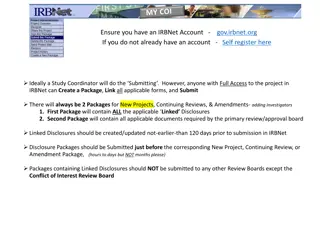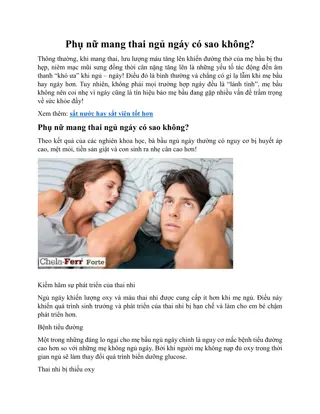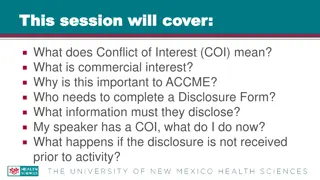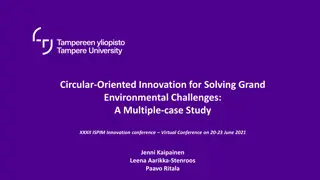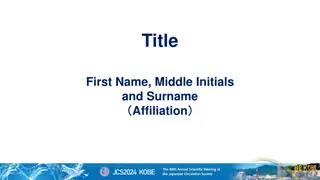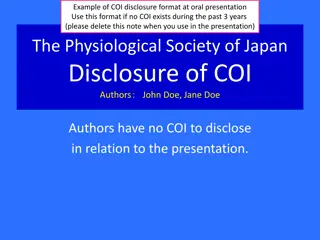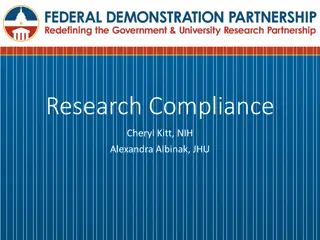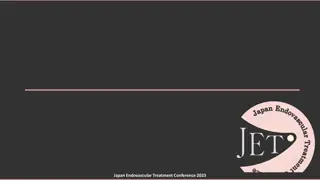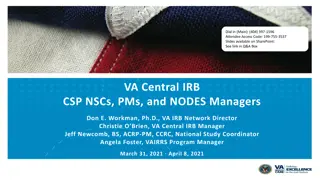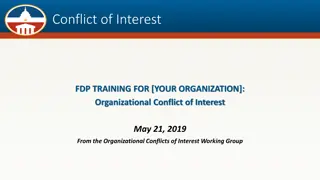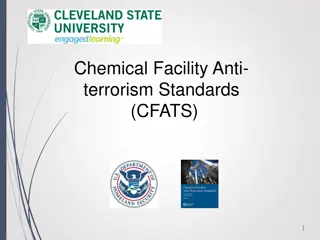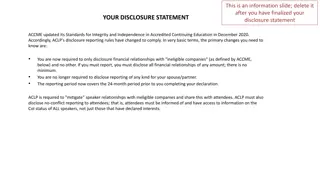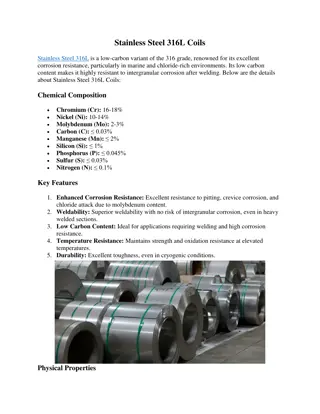
Understanding Faculty Consulting and Financial Conflicts in Research Settings
Explore a case study involving Dr. Person's involvement as a consultant and scientific collaborator for a pharmaceutical company in the realm of longevity research. Delve into the complexities of faculty serving as outside consultants, reporting obligations to universities, and financial conflict considerations under policies such as FAU Policy 8.3 and NIH guidelines.
Download Presentation

Please find below an Image/Link to download the presentation.
The content on the website is provided AS IS for your information and personal use only. It may not be sold, licensed, or shared on other websites without obtaining consent from the author. If you encounter any issues during the download, it is possible that the publisher has removed the file from their server.
You are allowed to download the files provided on this website for personal or commercial use, subject to the condition that they are used lawfully. All files are the property of their respective owners.
The content on the website is provided AS IS for your information and personal use only. It may not be sold, licensed, or shared on other websites without obtaining consent from the author.
E N D
Presentation Transcript
Research Roundtable: September 2024 Office of Compliance and Ethics Elizabeth Rubin, JD, Senior Corporate Council Research Integrity Office
Case Study Dr. Person was an undergraduate in the lab of one of the first researchers to successfully demonstrate the existence of a longevitygene in c. elegans, a type of roundworm. Since then, their passion has been the search for the expression of genes uniquely present in genetic variants of organisms that live significantly longer than average. They have turned the attention of their NIH-funded lab to fruit flies as a model organism, and the research group has successfully isolated a handful of genes that are highly expressed in fruit flies that live significantly longer than typical.
Case Study Dr. Person was contacted by a large pharmaceutical company, also interested in longevity, to be a professional consultant. Initially, they were interested in establishing a fruit fly colony that would include an aged population, and asked Dr. Person s help in the husbandry of the aged fruit flies. They invited Dr. Person to their corporate research labs about three times a year, each time paying their travel and a $2,000 honorarium. Discussion: Are faculty sometimes allowed to serve as outside consultants? If so, does Dr. Person need to report this to the university?
Discussion FAU Policy 8.3: Employees may engage in outside activities to further the dissemination and use of the knowledge and expertise; and/or advance the professional competence and reputation of the employee. Regulations and laws that must be considered in the area of conflicts of interest and conflicts of commitment, include without limitation: Florida Code of Ethics and other statutory provisions; University regulations and policies; Collective bargaining agreements (UFF CBA Article 19) Conflicts depend on the situation in which an individual is placed, rather than the character or actions of the individual. Employees must disclose outside activities and certain financial interests for supervisory review and approval (i.e., conflict clearance).
Case Study The relationship has evolved and now Dr. Person is serving a role more like a scientific collaborator than a consultant. They have now been asked to serve on the company s Scientific Advisory Board and as compensation will be getting some shares in the company stock currently worth about $12,000. Discussion: Should Dr. Person file a second report with the university? Under NIH Financial Conflict of Interest (FCOI) guidelines, must Dr. Person report any or all of travel reimbursements, stocks or direct payments from the company? Does the company have to report their compensation to Dr. Person?
Discussion All FAU employees possessing at least a .5 appointment at the University, except student employees, OPS employees and graduate teaching assistants, and any University employee engaged in the design, conduct, or reporting of research regardless of FTE, full-time, or part- time status are required to complete an outside activity report in a form directed by the University on or before Sept 30 of each year . If an employee has no information to disclose, a report must still be completed. Includes outside activity occurring during times during which the employee is on leave or has no active appointment (inclusive of summer or other off periods for 9-month appointments). If a change in the information occurs prior to the next reporting date, a new disclosure report must be submitted for approval prior to commencement of a new activity Disclosures may be made for anticipated activities of a similar nature that have smaller lead time Part-time, student, or OPS employees, including adjuncts and GTAs, as well as volunteers, emeritus faculty, and affiliates are generally but not required to report unless: they are engaged in the design, conduct or reporting or research, or they are asked to complete a disclosure by their supervisor for conflict review
Case Study The company has gifted $180,000 to Dr. Person s lab to cover a postdoctoral fellow for three years to work on a few collaborative projects. Dr. Person now spends about 15% of effort on the collaboration and 60% of effort on their NIH project. The remainder of their time is spent on teaching and committee service (25%). The trips to the company have increased, and sometimes Dr. Person must get other faculty members to cover their lectures because of this travel schedule. Discussion: Does Dr. Person have a conflict of commitment? How does this concept differ from the concept of a conflict of interest?
Discussion Conflict of Interest Conflict of Commitment Focuses on a financial, economic, professional or personal gain, interest or advantage of any kind from the person s position with the University in a manner that may (or may appear to): Inappropriately influence the person s professional judgment, Compromise the person s abilities to carry out institutional responsibilities, Adversely affect the educational programs and professional careers of individual students and faculty members, or Misuse or re-allocate University personnel and resources for private gain. Focuses on the distribution of effort between a University appointment, obligation, or commitment versus the effort devoted to external professionally-related or personal activities. Assesses the burden on, or interference with, the employee s primary obligations and commitments to the University. Individualized determination considering the employee s specific work responsibilities and obligations to FAU, including, but not limited to: Job description/offer letter regarding expectations and duties Performance appraisals Benchmarks for assessment Expectations outside of regular business hours
Case Study At a recent research meeting at the company, Dr. Person and the Board could clearly see a potentially patentable product emerging from their joint line of inquiry. This product, which stimulates expression of the longevity genes, has the potential of providing a therapy to slow the onset of aging in humans, which is extremely exciting and could be quite lucrative. However, the Scientific Advisory Board would need to decide whether to publish their findings, and how to protect the intellectual property rights emerging from this research. The Board asks which parties need to be represented legally as the push to commercialize the product moves forward: Dr. Person, their postdoctoral fellow, the institution?
Case Study Dr. Person feels that, while their research group contributed to the success of the project, direct experiments related to the product were not performed by any NIH-funded personnel. And, they have spent much effort at night and on weekends on the company s project. Therefore, they feel that it is fair that their intellectual property (IP) interests be represented, but not necessarily the school s interests. Dr. Person feels as though, since they fulfilled teaching, service, and research efforts at the school during this time period, all additional efforts they may have made were on their own behalf. Further, Dr. Person feels that since the postdoctoral fellow was getting their training on this project, the postdoc has not really earned any additional benefit for participation in the project. Discussion: When should IP/patent rights be discussed and determined in a collaborative project? By what mechanism does that occur at FAU? What special issues might arise for the postdoctoral fellow whose stipend is paid through a gift from a company, such as in this case?
Discussion The FCOI Committee is required to determine whether disclosed outside interests have the potential to significantly affect the design, conduct, or reporting of funded research. All outside interests, including IP and patent rights, should be disclosed in an SFI (Significant Financial Interest) disclosure. SFI disclosures should be updated annually and whenever interests change. Outside interests can affect the design, conduct, or reporting of funded research without being directly involved in the research if the goals of the research and the goals of the outside interest align in a way that has the potential to benefit the outside interest or the investigator. FCOI Policy: 10.1.2 https://www.fau.edu/research-admin/research-integrity/financial-conflict- of-interest-in-research/
Acknowledgments Case Study adapted from HHS Office of Research Integrity: https://ori.hhs.gov/case-one-age-old-conflicts Other study materials available: https://ccnmtl.columbia.edu/projects/rcr/rcr_conflicts/
Questions? Research Integrity Office of Compliance and Ethics










